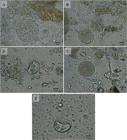Abstract
Balantidium coli is a protozoon that can cause dysentery in humans, pigs and nonhuman primates, with zoonotic potential. In the literature, there is still little information on the effectiveness of different laboratory techniques for diagnosing this disease. This study compared and evaluated the performance of the Lutz, modified Ritchie, Faust, modified Sheather and direct examination techniques for detecting cysts of this protozoon. Between 2012 and 2014, 1905 fecal samples were collected from captive animals in the state of Rio de Janeiro. Of these, 790 were obtained from the rectum of pigs and 1115 from enclosures occupied by nonhuman primates. B. coli cysts were most evident through direct examination (22.4% of the samples) and the Lutz technique (21%). Fair agreement (Kappa = 0.41; p < 0.05) was observed only between direct examination and Lutz. The flotation techniques (Faust and modified Sheather) did not show good recovery of cysts. A statistically significant difference (p < 0.05) in the frequency of cysts between pigs and nonhuman primates could only be observed through direct examination and the Lutz technique. The most efficient method for diagnosing this parasitosis was seen to an association between direct examination and the spontaneous sedimentation technique.
Keywords:
Balantidium coli; parasitological techniques; cysts; laboratory diagnosis

 Thumbnail
Thumbnail
